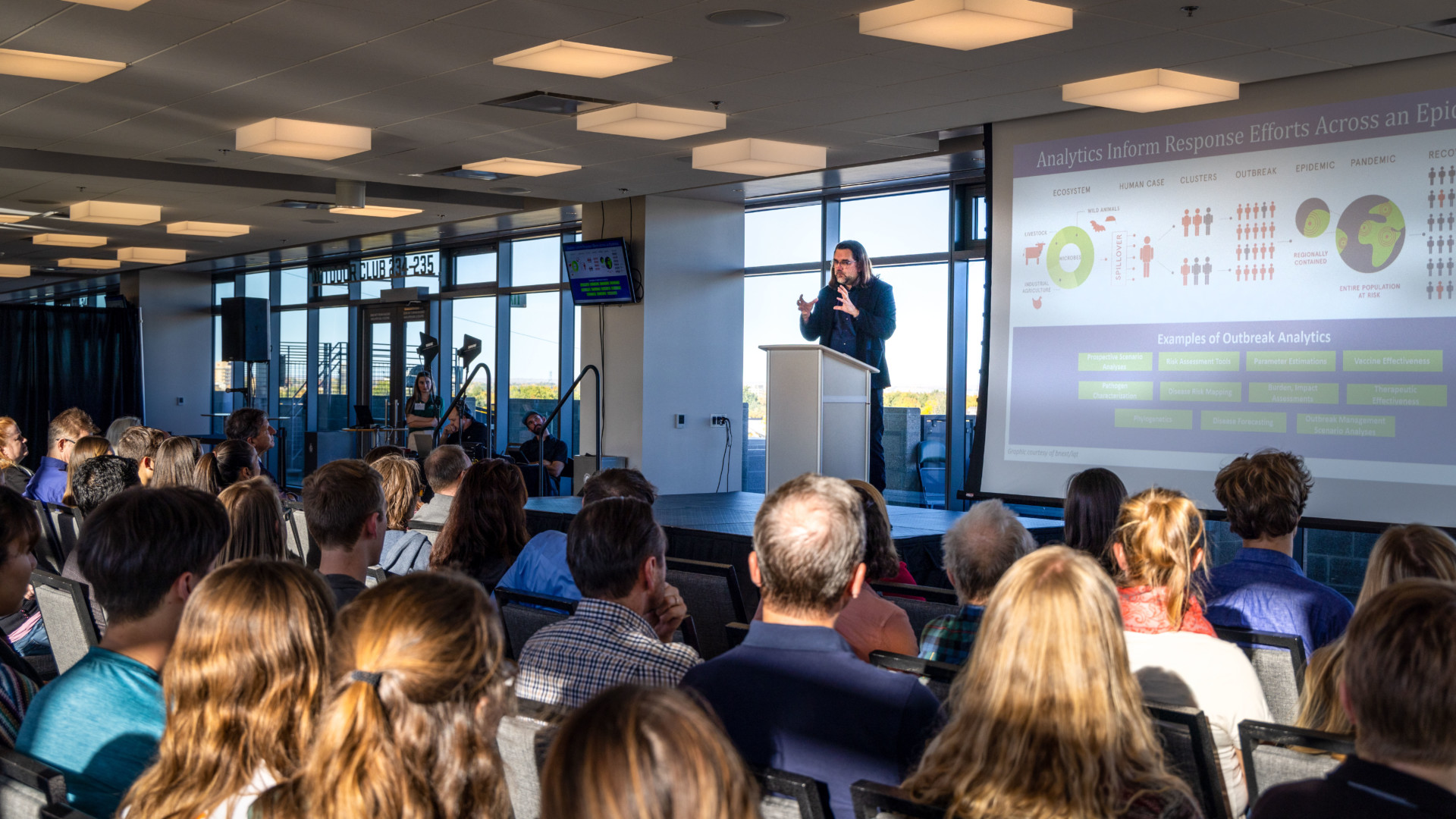
Dylan George, a CSU alumnus who is now the operations director of the CDC’s new Center for Forecasting and Outbreak Analytics (CFA), delivered a presentation at the Canvas Stadium Club on Wednesday, Oct. 19. (Photo: John Cline)
Early warnings about potentially devastating storms save lives. This same principle applies to pandemics, and Dylan George and his team at the Centers for Disease Control and Prevention are working to apply some of the data science skills he honed at Colorado State University to forecast the spread of diseases like meteorologists do the weather.
“We need to understand what is the risk of that weird thing that is happening, who is most at risk, and how is it spreading?’” said George, a CSU alumnus who is now the operations director of the CDC’s new Center for Forecasting and Outbreak Analytics (CFA).
He returned to Fort Collins on Oct. 19 for a public event sponsored by the Office of the Vice President for Research at the Canvas Stadium Club to discuss the CFA’s mission to quickly respond to disease outbreaks and provide public health officials with the tools they need to respond proactively. Some 150 people attended either live or via remote connection, and George was introduced by his adviser Colleen Webb, now the associate dean of the CSU Graduate School.
George’s team has already had a tangible impact on the U.S. response to COVID-19. On Thanksgiving 2021, while he was eating dinner with his family, George said he received a call from a colleague about an alarming new variant out of South Africa called Omicron.
He and a group of scientists sprang into action, and were later able to partner with Kaiser Permanente Southern California and the University of California, Berkeley to produce the first estimates of Omicron’s severity compared to previous variants. Their models also showed that the virus was going to spike in January, giving public health officials and hospitals the warning they needed to prepare for an influx in COVID-19 patients.
However, obtaining this data isn’t something the federal government can do alone. George emphasized the need for bolstering local public health infrastructure to ensure that data is complete and available as early as possible, so that his team and others can detect potential risks before they reach crisis level.
“The reason that we got pretty good at weather forecasting is because the nation invested in data, computational power, modeling abilities and academics that could improve these skills – and sustained that funding over decades,” he said.
George explained that the ability to forecast pandemics is not as sophisticated as the models that predict the weather, but said he is hopeful that it can soon catch up.
“I believe we are at a transformative moment,” he said. “We have the leadership, we have the resources, we have the vision, and I think we have the technology to make this move forward.”
Research institutions like CSU are paving the way. The University is a national leader in infectious disease research, particularly in studying zoonotic disease transmission between animals and humans.
While he was earning his doctorate in biological science in CSU’s College of Natural Sciences, George focused on quantitative analytical approaches to consider how clinically severe pathogens like rabies persist within wildlife populations.
In his current role, George and his team aren’t just tracking the COVID-19 pandemic; they’re also gathering data about the monkeypox outbreak and pediatric acute hepatitis, as they work to bolster their forecasting tools to respond to the next public health threat.
“It’s clear that these data-driven decisions require new analytical tools, tools that Dr. George is helping our country not just develop, but use,” said CSU Interim President Rick Miranda. “These tools will help us in future pandemics, and that’s why it’s so significant that we’re producing leaders here at Colorado State who are like Dr. George.”